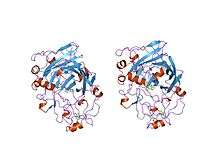Glycoside hydrolase family 7
| Glycosyl hydrolase family 7 | |||||||||
|---|---|---|---|---|---|---|---|---|---|
 endoglucanase i complexed with epoxybutyl cellobiose | |||||||||
| Identifiers | |||||||||
| Symbol | Glyco_hydro_7 | ||||||||
| Pfam | PF00840 | ||||||||
| Pfam clan | CL0004 | ||||||||
| InterPro | IPR001722 | ||||||||
| SCOP | 1cel | ||||||||
| SUPERFAMILY | 1cel | ||||||||
| CAZy | GH7 | ||||||||
| CDD | cd07999 | ||||||||
| |||||||||
In molecular biology, glycoside hydrolase family 7 is a family of glycoside hydrolases.
Glycoside hydrolases EC 3.2.1. are a widespread group of enzymes that hydrolyse the glycosidic bond between two or more carbohydrates, or between a carbohydrate and a non-carbohydrate moiety. A classification system for glycoside hydrolases, based on sequence similarity, has led to the definition of >100 different families.[1][2][3] This classification is available on the CAZy(http://www.cazy.org/GH1.html) web site,[4] and also discussed at CAZypedia, an online encyclopedia of carbohydrate active enzymes.[5]
Glycoside hydrolase family 7 CAZY GH_7 comprises enzymes with several known activities including endoglucanase (EC 3.2.1.4) and cellobiohydrolase (EC 3.2.1.91). These enzymes were formerly known as cellulase family C.
Exoglucanases and cellobiohydrolases[6] play a role in the conversion of cellulose to glucose by cutting the disaccharide cellobiose from the non-reducing end of the cellulose polymer chain. Structurally, cellulases and xylanases frequently consist of a catalytic domain joined to a cellulose-binding domain (CBD) via a linker region that is rich in proline and/or hydroxy-amino acids. In type I exoglucanases, the CBD domain is found at the C-terminal extremity of these enzyme (this short domain forms a hairpin loop structure stabilised by 2 disulphide bridges).
References
- ↑ Henrissat B, Callebaut I, Mornon JP, Fabrega S, Lehn P, Davies G (1995). "Conserved catalytic machinery and the prediction of a common fold for several families of glycosyl hydrolases". Proc. Natl. Acad. Sci. U.S.A. 92 (15): 7090–7094. doi:10.1073/pnas.92.15.7090. PMC 41477
 . PMID 7624375.
. PMID 7624375. - ↑ Henrissat B, Davies G (1995). "Structures and mechanisms of glycosyl hydrolases". Structure. 3 (9): 853–859. doi:10.1016/S0969-2126(01)00220-9. PMID 8535779.
- ↑ Bairoch, A. "Classification of glycosyl hydrolase families and index of glycosyl hydrolase entries in SWISS-PROT". 1999.
- ↑ Henrissat, B. and Coutinho P.M. "Carbohydrate-Active Enzymes server". 1999.
- ↑ CAZypedia, an online encyclopedia of carbohydrate-active enzymes.
- ↑ Gilkes NR, Kilburn DG, Henrissat B, Miller Jr RC, Warren RA (1991). "Domains in microbial beta-1, 4-glycanases: sequence conservation, function, and enzyme families". Microbiol. Rev. 55 (2): 303–315. PMC 372816
 . PMID 1886523.
. PMID 1886523.
This article incorporates text from the public domain Pfam and InterPro IPR001722